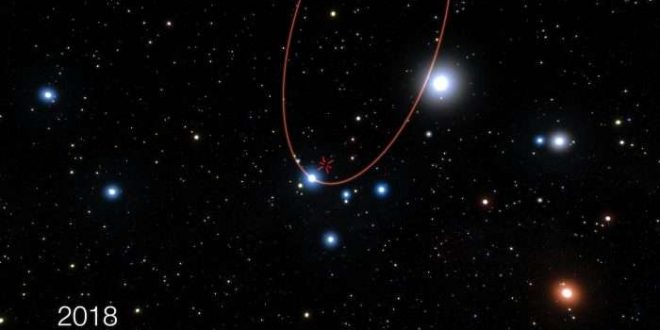Astronomers working with the European Space Agency’s (ESO) Very Large Telescope (VLT) in Chile have just announced that a black hole-observing device called GRAVITY is now fully operational on all four of the VLT’s 8.2 metre (26.9 foot) Unit Telescopes – and it’s has already provided one accurate measurement.
GRAVITY is part of the VLT Interferometer. By combining light from the four telescopes it can achieve the same spatial resolution and precision in measuring positions as a telescope of up to 130 metres in diameter. The corresponding gains in resolving power and positional accuracy — a factor of 15 over the individual 8.2-metre VLT Unit Telescopes — will enable GRAVITY to make amazingly accurate measurements of astronomical objects.
One of GRAVITY’s primary goals is to make detailed observations of the surroundings of the 4 million solar mass black hole at the very centre of the Milky Way. Although the position and mass of the black hole have been known since 2002, by making precision measurements of the motions of stars orbiting it, GRAVITY will allow astronomers to probe the gravitational field around the black hole in unprecedented detail, providing a unique test of Einstein’s general theory of relativity.
In this regard, the first observations with GRAVITY are already very exciting. The GRAVITY team has used the instrument to observe a star known as S2 as it orbits the black hole at the centre of our galaxy with a period of only 16 years. These tests have impressively demonstrated GRAVITY’s sensitivity as it was able to see this faint star in just a few minutes of observation.
The team will soon be able to obtain ultra-precise positions of the orbiting star, equivalent to measuring the position of an object on the Moon with centimetre precision. That will enable them to determine whether the motion around the black hole follows the predictions of Einstein’s general relativity — or not. The new observations show that the Galactic Centre is as ideal a laboratory as one can hope for.
“It was a fantastic moment for the whole team when the light from the star interfered for the first time — after eight years of hard work,” says GRAVITY’s lead scientist Frank Eisenhauer from the Max Planck Institute for Extraterrestrial Physics in Garching, Germany. “First we actively stabilised the interference on a bright nearby star, and then only a few minutes later we could really see the interference from the faint star — to a lot of high-fives.” At first glance neither the reference star nor the orbiting star have massive companions that would complicate the observations and analysis. “They are ideal probes,” explains Eisenhauer.
This early indication of success does not come a moment too soon. In 2018 the S2 star will be at its closest to the black hole, just 17 light-hours away from it and travelling at almost 30 million kilometres per hour, or 2.5% of the speed of light. At this distance the effects due to general relativity will be most pronounced and GRAVITY observations will yield their most important results. This opportunity will not be repeated for another 16 years.
Agencies/Canadajournal
 Canada Journal – News of the World Articles and videos to bring you the biggest Canadian news stories from across the country every day
Canada Journal – News of the World Articles and videos to bring you the biggest Canadian news stories from across the country every day



